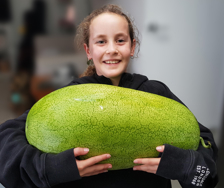Yates Account
Join now
Create a Yates account today!
Sign up to join the Yates Garden Club for monthly e-mails packed with seasonal inspiration, tips for success & exclusive promotions.
Plus if you’re a Garden Club member you can take part in the Yates Growing Community - a blog to share successes, get advice & win prizes in fun challenges along the way!

Forgot password
Enter the email address associated with your account, and we'll email you a new password.
Hemiptera / Sternorrhyncha

What are Whiteflies?
They're small white-winged sap-sucking insects, that aren't actually flies at all. They resemble tiny white moths with a wingspan of 3mm. Whiteflies have become very prevalent in recent years and there are several different types which are major pests for home gardeners. Both the adult and juvenile (nymph) whiteflies feed by sucking the phloem sap from plants, causing a lot of damage in the process. Infestations of whitefly can drastically impede plant growth and reduce crop yields.
The Greenhouse Whitefly (Trialeurodes vaporariorum) and the Sweet Potato Whitefly (Bemisia tabaci) are the most commonly encountered pest species in NZ. The Australian Citrus Whitefly (Orchamoplatus citri) is also found in the Auckland, Northland, Bay of Plenty and Hawkes Bay regions.
Whitefly are easy to identify: if the plant host is disturbed, a distinctive 'flittering cloud' of tiny insects fly out, but they soon settle back onto the same plant.

Whitefly is challenging to control, because it goes through two life stages that are resistant to pesticides. This explains why a single spray won't always control it completely. A quick explanation of the whitefly life cycle will be helpful to understand why.
The winged adults are usually found feeding on growing tips and new leaves. The females lay eggs on young leaves, close to where they are feeding. When the eggs hatch out, they go through four different larval stages, that look like tiny scale insects. The last larval stage stops feeding when fully grown and forms a pupa.
The challenge is that the egg and pupal stages are quite resistant to pesticides (although the adults and youngest nymphs are easily controlled by most pesticides). Because you can usually find all the different whitefly life stages on the same leaf at the same time, a single spray often won't kill them all, so the survivors can quickly mature and carry on feeding. When whitefly pest pressure is high, this can allow their population to recover before the next scheduled insecticide spray is due.
Symptoms
Wilting and stunting of new shoots. Can cause silvering and yellowing of leaves, uneven ripening of tomatoes and sometimes plant death.
Sooty mould often accompanies large numbers of whiteflies, because like many other sucking pests, they excrete honeydew when feeding on plant sap.

How to Protect your plants
Whitefly is best controlled using two different insecticides and alternating them, in overlapping applications. Don't be tempted to shorten the spray intervals of any of our whitefly control products (always stick to the instructions) because whitefly can build up chemical resistance very quickly.
Instead, if you alternate between different insecticides with different modes of action, this delivers the effect you're looking for.
For example, if you apply Yates Mavrik at the weekend, sticking to 1-week spray intervals, and then alternate with a mid-week dose of Yates Nature's Way Natrasoap Vegie Insect Spray at 1-week intervals, you'll be able to interrupt the whitefly life cycle and get complete control. Ensure you get complete spray coverage, including on the underside of leaves.
Spraying is best done in the early morning or late afternoon while the insects aren't as active.
Plants impacted
- Tomato
- Beans
- Broccoli
- Squash
- Melon
- Eggplant
- Cabbage
- Citrus
- Sage
- Mint
- Hibiscus
- Gerberas
- Poinsettia
















Share
Share this article on social media